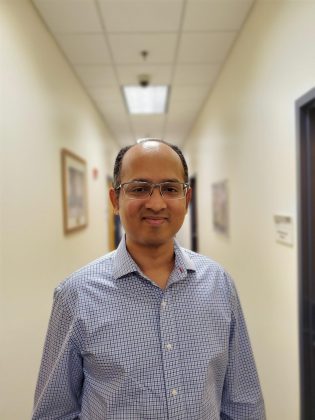Yogeswaran Umasankar

Post-Doc
Current Research Interests
- Trans dermal biosensors for organic volatile compounds The chemical signatures of organic volatile compounds can be used as biomarkers for diagnosing and monitoring one’s health. Breathalyzers with fuel cell sensors are widely used as a noninvasive technique; however, theycannot be used for continuous measurements due to the need for breath input for each measurement. A miniature fuel cell sensor capable of monitoring organic volatile compounds emitted from the skin through sensible and insensible perspiration has been studied. Among various organic volatile compounds, i. ethanol to monitor blood alcohol content, ii. acetone to monitor ketoacidosis and iii. isoflurane to monitor anesthesia was chosen. The research focuses on i.understanding and modeling the relationship between the ambient environment with signal interference, ii. understanding the effect of the organic volatile mixture on the sensor signal, iii. designing sensor array to collect and understand data on organic volatile mixtures. Some of the preliminary work includes modeling principle component regression.
- Wearable biosensor for wound healing monitoring Chronic wounds, a silent epidemic with an alarming diagnosis rate creating an enormous burden to the financial structure of our healthcare economy. In the United States alone 6.5 million patients suffer from a chronic wound which is about 2% of the population. Wound management involves repeated clinical trips and procedures of lab tests over days. Current wound monitoring practices are simply visual and wound assessments by measuring guides and optical images. To eliminate this time lag and provide real-time monitoring of a wound’s progress, enzymatic biosensors on the flexible gauze has been studied for continuous monitoring of biomarkers in wound fluids and in the sweat. The research focuses on i. stability and the lifetime of the enzymes on the biosensors, ii. loading of the enzymes and its relationship with the sensor signal, iii. study of polymer matrices to improve ionic conductance and enzyme stability.
Recent Patents
- US 10, 667, 732 – Method for transdermal measurement of volatile anesthetics (Inventors: Y. Umasankar; S. Bhansali, E.A. Pretto, Jr.)
- US 10,712,306 – Sensor for detection of acetone (Inventors: Y. Umasankar, S. Bhansali, AH Jalal, N. Bhansali)
Recent Publications
- T. Songkakul, P. Bhushan, Y. Umasankar, M. Yokus, MA. Daniele, S. Bhansali, A. Bozkurt “Towards a Long-Term Multi-Site Electrochemical Wound Monitoring System.” 2019 IEEE SENSORS. IEEE, 2019.
- P. Hirt, Y.Umasankar, P.Bhushan, L. Borda, S. McNamara, C. Chen, F. MacQuhae, S. Bhansali, R. Kirsner, H. Lev-Tov “Uric acid levels in chronic wounds are elevated compared with adjacent normal skin: 10511.” Journal of the American Academy of Dermatology 81.4 (2019).
- P. Bhushan, Y. Umasankar, JD. Hutcheson, S. Bhansali “Toxicity assessment of wearable wound sensor constituents on keratinocytes.” Toxicology in Vitro 58 (2019): 170-177.
- P. Bhushan, Y. Umasankar, S. RoyChoudhury, PA Hirt, FE. MacQuhaec, LJ. Borda, HA. Lev-Tov, RS. Kirsner, S. Bhansali “Biosensor for Monitoring Uric Acid in Wound and Its Proximity: A Potential Wound Diagnostic Tool.” Journal of The Electrochemical Society 166.10 (2019): B830.
- S. RoyChoudhury, Y. Umasankar, P. Bhushan, PA. Hirt, FE. MacQuhae, LJ. Borda, HA. Lev-Tov, R. Kirsner, S. Bhansali “Nanocomposite Bienzymatic Sensor for Monitoring Xanthine in Wound Diagnostics.” Journal of The Electrochemical Society 166.9 (2019): B3295.
- AH. Jalal, Y. Umasankar, Md A. Ahmed, EA. Pretto, S. Bhansali “Towards a wearable fuel cell sensor for transdermal monitoring of isoflurane–an anesthetic.” Analytical Methods 11.15 (2019): 2007-2012.
What is Yogeswaran Umasankar working on?